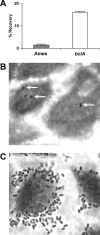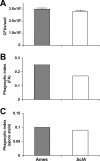Bacillus anthracis spores of the bclA mutant exhibit increased adherence to epithelial cells, fibroblasts, and endothelial cells but not to macrophages
- PMID: 17606596
- PMCID: PMC1951178
- DOI: 10.1128/IAI.00434-07
Bacillus anthracis spores of the bclA mutant exhibit increased adherence to epithelial cells, fibroblasts, and endothelial cells but not to macrophages
Abstract
Bacillus anthracis is the causative agent of anthrax, and the spore form of the bacterium represents the infectious particle introduced into a host. The spore is surrounded by an exosporium, a loose-fitting membrane composed of proteins and carbohydrates from which hair-like projections extend. These projections are composed mainly of BclA (Bacillus-collagen-like protein of B. anthracis). To date, exact roles of the exosporium structure and BclA protein remain undetermined. We examined differences in spore binding of wild-type Ames and a bclA mutant of B. anthracis to bronchial epithelial cells as well as to the following other epithelial cells: A549, CHO, and Caco-2 cells; the IMR-90 fibroblast line; and human umbilical vein vascular endothelium cells. The binding of wild-type Ames spores to bronchial epithelial cells appeared to be a dose-dependent, receptor-ligand-mediated event. There were similar findings for the bclA mutant, with an additional nonspecific binding component likely leading to significantly more adherence to all nonprofessional phagocytic cell types. In contrast, we detected no difference in adherence and uptake of spores by macrophages for either the wild-type Ames or the bclA mutant strain. These results suggest that one potential role of the BclA fibers may be to inhibit nonspecific interactions between B. anthracis spores with nonprofessional phagocytic cells and thus direct the spores towards uptake by macrophages during initiation of infection in mammals.
Figures






References
-
- Bozue, J. A., N. Parthasarathy, L. R. Phillips, C. K. Cote, P. F. Fellows, I. Mendelson, A. Shafferman, and A. M. Friedlander. 2005. Construction of a rhamnose mutation in Bacillus anthracis affects adherence to macrophages but not virulence in guinea pigs. Microb. Pathog. 38:1-12. - PubMed
-
- Charlton, S., A. J. Moir, L. Baillie, and A. Moir. 1999. Characterization of the exosporium of Bacillus cereus. J. Appl. Microbiol. 87:241-245. - PubMed
Publication types
MeSH terms
Substances
LinkOut - more resources
Full Text Sources

